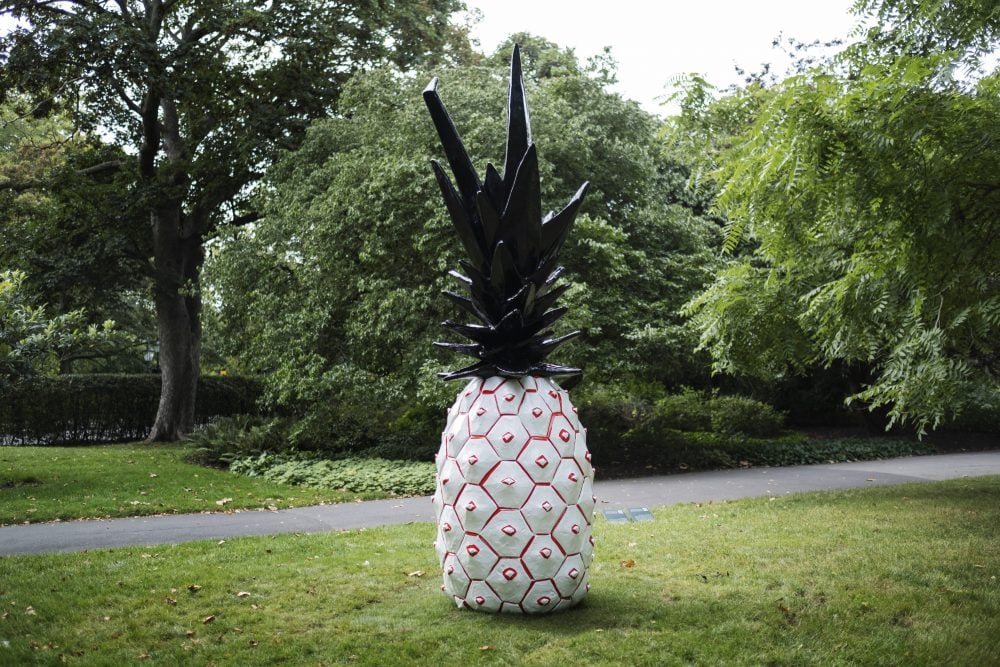
Signs of fall have arrived in London. The air is brisk, leaves are beginning to change color, and a promenade through one of London’s royal parks leads to a parcours of contemporary sculpture. It can only mean one thing: Frieze Week is around the corner.
Now a yearly fixture teasing the arrival of the Frieze fairs in Regent’s Park, Frieze Sculpture opened to the public on September 14, a little later in the year than its usual summer opening due to ongoing complications relating to shipping.
At the unveiling, Frieze London’s artistic director Eva Langret promised that Frieze and Frieze Masters, returning October 13–17 after a pandemic hiatus, will be back in force. The curator of the sculpture program, Clare Lilley (who is also the director of program at Yorkshire Sculpture Park), highlighted the global character of this year’s selection, with artists hailing from South America, South and North Africa, Indonesia, Pakistan, the U.S. and Canada, and Europe.
“I see exciting sculptural conversations across time and geography, and while many sculptures here relate to social and environmental concerns, there is much heightened color and dextrous handling of material, resulting in an overall sense that is celebratory,” Lilley said in a statement. “As we learn to live with the pandemic and emerge into public spaces, Frieze Sculpture 2021 allows people to come together in safety and with pleasure and is a tonic for the mind, body, and soul.”
Counterspace, fragment of Serpentine Pavilion 2021 for Frieze Sculpture 2021. Presented by Serpentine Galleries, London. Photo: Linda Nylind, courtesy of Linda Nylind/Frieze.
The works, by 18 artists spanning three generations, range from soapstone skulls by Solange Pessoa to a quirky pineapple courtesy of Rose Wylie to Vanessa da Silva’s joyful steel-and-fiberglass figures, Muamba Grove.
One highlight is a fragment of this year’s Serpentine Pavilion, a gathering table designed by Johannesburg architectural studio Counterspace; its inclusion marks the first time one of the U.K.’s public institutions has taken part in the Frieze initiative (the other works are presented by commercial galleries). By extending the pavilion’s tendrils outside of its traditional home in Hyde Park, the installation is suggestive of themes relating to migration and displacement. Another notable entry is artist-preservationist Jorge Otero-Pailos’s Biosignature Preservation (2019), a repurposing of the security fence erected by the U.S. Embassy in Oslo after 9/11 that recalls contorted iron rebar left after bombings or natural disaster.
Frieze Sculpture is on view at the English Gardens in Regent’s Park, London, through October 31. See more images below.
Stoyan Dechev, Event Horizon (2019), presented by Anca Poterasu Gallery and supported by the London office of the Romanian Cultural Institute. Frieze Sculpture 2021. Photo by Linda Nylind. Courtesy of Linda Nylind/ Frieze.
Annie Morris, Stack 9, Ultramarine Blue (2021), presented by Timothy Taylor. Photo: Linda Nylind, courtesy of Linda Nylind/Frieze.
Anthony Caro, Palanquin (1987/1991), presented by New Art Centre. Photo: Linda Nylind, courtesy of Linda Nylind/Frieze.
Jorge Otero-Pailos, Biosignature Preservation (2019), presented by Holtermann Fine Art. Photo: Linda Nylind, courtesy of Linda Nylind/Frieze.
Isamu Noguchi, Play Sculpture, ca. 1965/ca. 1980 (fabricated 2021), presented by White Cube. Photo: Linda Nylind, courtesy of Linda Nylind/Frieze.
Vanessa da Silva, Muamba Grove #1, #3, and #4 (2019), presented by Galeria Duarte Sequeira. Photo: Linda Nylind, courtesy of Linda Nylind/Frieze.
Gisela Colón, Quantum Shift (Parabolic Monolith Sirius Titanium) (2021), presented by Gavlak. Photo: Linda Nylind, courtesy of Linda Nylind/Frieze.
Ibrahim El-Salahi, Meditation Tree (2018), presented by Vigo Gallery. Photo: Linda Nylind, courtesy of Linda Nylind/Frieze.
Tatiana Wolska, Untitled (module 1 and 2) (2019), presented by L’Etrangère and Irène Laub Gallery. Photo: Linda Nylind, courtesy of Linda Nylind/Frieze.
Solange Pessoa, Untitled, from “Skull” series (2016), presented by Mendes Wood DM. Photo: Linda Nylind, courtesy of Linda Nylind/Frieze.
Rasheed Araeen, Lovers in The Regent’s Park (2021), presented by Grosvenor Gallery. Frieze Sculpture 2021. Photo by Linda Nylind. Courtesy of Linda Nylind/Frieze.
Rose Wylie, Pineapple (2020), presented by David Zwirner. Photo: Linda Nylind, courtesy of Linda Nylind/Frieze.
Yunizar, Induk Monster (Mother Monster) (2017), presented by Gajah Gallery. Photo: Linda Nylind, courtesy of Linda Nylind/Frieze.